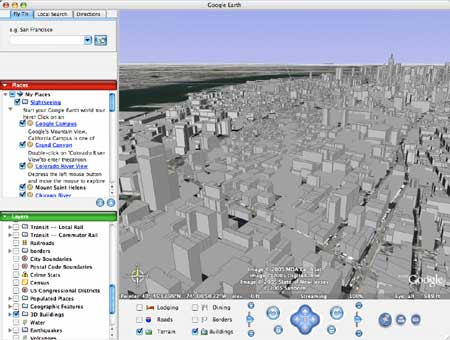I got myself a copy of the Google Earth for Mac OS X beta application, a prerelease that was let loose on the web this morning, and have now played with it for a while. Here are my usage notes, including news of a special feature in the Mac version that is not in the PC version (near the end of the post, alas).
Test machines were an Apple PowerMac G5 Quad with an NVIDIA 6600, crippled by just 512 MB of RAM, and a PowerBook G4 Titantium 867MHz with an ATI Mobility Radeon 9000 and 1GB of RAM. Both run OS X 10.4.3. The internet connection is 100 Mbps downstream (bless Sweden).
First impression: It works very well for a prerelease and it’s as impressive as when I saw Google Earth on the PC for the first time..
Second impression. 512 MB is not enough to run this. The Quad experiences hiccups amid the scrolling, no doubt because the limited memory needs to engage in gymnastics as the application sucks in new data. So plan to get at least 1GB of RAM to play with Google Earth for Mac.
The PowerBook performed well, as long as you don’t go and hover over New York and turn on 3D buildings. Given sufficient RAM, it certainly looks likely that anything equivalent to a late model Titanium will be able to make good use of this application.
Click to enlarge.
3D buildings are still a bit iffy in the Mac prerelease beta. In New York, certain buildings along a N/S E/W grid lacked shading and borders. That’s the case on both Macs, so its unlikely to be a graphics card artifact. However, the transparency slider for overlays works fine, as do all the network links I’ve tested, save for rendering images inside info boxes (such as the National Geographic content).
All the items in the Layers and Places panels are identical, including the icons, but that’s because they are fed by a server, not hard-coded in the application.
Feature-wise, Menu items are identical, right down to the icons. The Measure tool works, Image Overlay works, adding placemarks works, the Overview map works, Snapshot View works… pretty much everything works, except for Web, which currently leads to a white space where on the PC we get a web browser. The Email function isn’t implemented yet. (“Sorry about this” says the pop-up window. Don’t be!) Other functions require Google Earth Plus, as on the PC.
In my preferences folder there is now a “com.Google.GoogleEarthPlus.plist”. My grabby hand/cursor went transparent once, so I trashed this file and the hand was back upon a relaunch.
The only showstopper I found is choosing Full Screen. That presents you with a full screen of white that you need to quit out of. I never got this application to crash properly, though.
Options are called Preferences in Google Earth for Mac, and these are nearly exactly indentical to the PC counterpart, pane by pane, down to the choice between Open GL and Direct X as the Graphics Mode (Choosing Direct X seems to have no effect on the Mac, even though in the About box it will then say that the renderer is DirectX 8. Weird.).
There is one feature in the Mac version that doesn’t exist on the PC version. The Mac version has an additional viewing mode: There’s Trackball, G-Force, and Click-and-Zoom, just like in the PC version, but also Camera, which turns the controls into something akin to the yoke of a small plane (I imagine). Takes a bit of getting used to, but it can be handy for making fine adjustments to snapshots. Or pretending to be an out-of-control astronaut.
In sum, if you’re a Mac enthusiast who’s been pining after this application, this prerelease version already lets you be far more productive than running it in Virtual PC. In fact, as long as you remember that this is not a public release, and that some features are not ready yet, this version is perfectly usable.
PS Currently there is no AppleScript support (not that I was expecting any:-), but there is this: in the application’s info.plist (look inside the application’s package contents):
<key>NSAppleScriptEnabled</key>
<string>YES</string>
Which means that Google Earth gets listed as scriptable. And that’s indeed the case. When you try to open the Dictionary via Script Editor, however, nothing happens.
PPS When downloading a KML or KMZ file in Firefox for the first time, it will ask you if you want to open it automatically in a certain application. This way, future clicks on KML or KMZ files on the web will open them directly in Google Earth.
If you are downloading KML or KMZ files from Safari and want them to open automatically in Google Earth, you are apparently out of luck.
PPPS For reference’s sake, this version of Google Earth for Mac is 3.1.0371.0 (beta), built on December 1, 2005.

Looks like the leaked build is 10.4 only…
…yeah, those of us who don’t have Mac OS X 10.4 seem to be SOL.
excelente